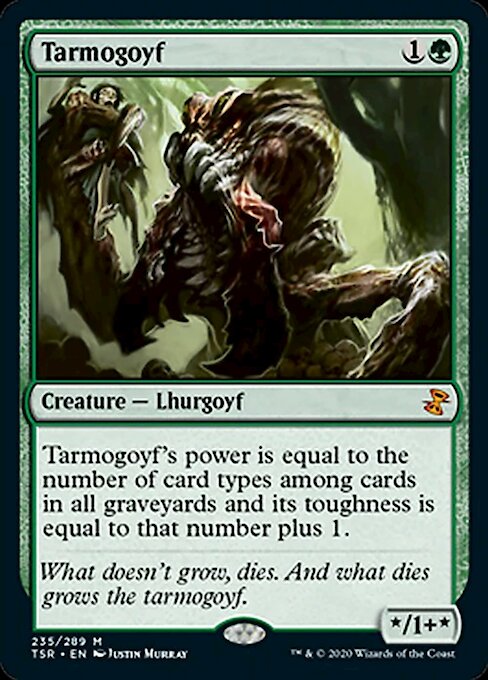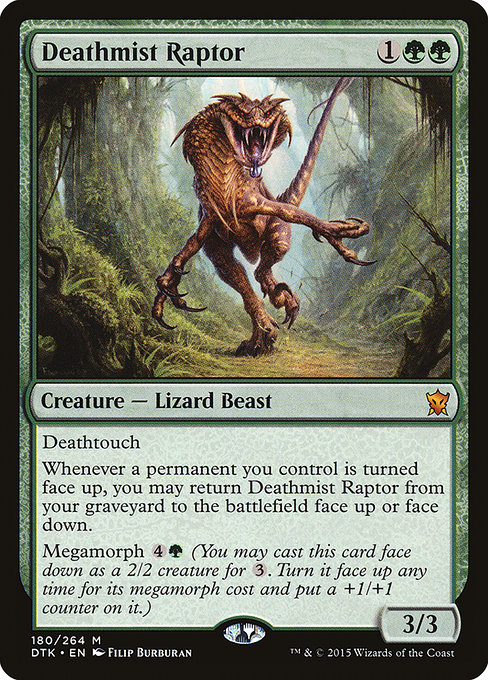Are you a Quiet Speculation member?
If not, now is a perfect time to join up! Our powerful tools, breaking-news analysis, and exclusive Discord channel will make sure you stay up to date and ahead of the curve.
One of the reasons we talk to each other about Magic card prices is to get a better idea of what's really going on with the market. We're all in this so we can be a little less wrong, a little more right.
In this article, we'll look at historical examples of times we---you---me---all of us got it wrong. If we can, we'll try to learn some lessons so we can put them into practice for Oath of the Gatewatch.
Playing with Spoiled Cards
With an early spoiler, we have four or five weeks of looking at the card before we greedily crack it open at the prerelease. It's really easy to dismiss a card when we have nothing but theorycrafting to go on.
This is probably the most important reason why we miss stuff. Why we miss out on a creature like Tarmogoyf.
Goyf's story is really old, considering that it was printed in 2007. The internet was already a thing back then! I recall that Goyf was dismissed for Standard play because it was kind of bad (and it was). Aside from Tarfire double-powering it, Goyf couldn't get big in Standard.
However, it found a quick home in Legacy, where a fetchland and Brainstorm could send it sky-high on the first few turns. And in spite of its future as a cross-format powerhouse, the general consensus on release was that it wasn't much better than Werebear.
The critical error was that nobody was actually playing with the card! Sharpies existed; we could have mocked up Tarmogoyfs, realized they were nuts and bought them for $1 on presale. But conventional wisdom took hold and said, "Why waste your time trying this thing out?"
The lesson is clear: if a card has potential, try it out. There are myriad ways we can go about this other than brewing a whole new deck from scratch.
First, you can seed a new card in your opening hand in an existing deck and see if it plays well. You can also pretend to draw it on the turn when you'll have the mana for it and see if it's something you want to cast.
Or, you can just shuffle four of them up in a sixty-card deck and see what it's like to naturally draw and play multiples. Sixty-four cards, the sacrilege!
Finally, you can just take the plunge and proxy up a brew incorporating the new card. Who knows, you might hit it big on the finance front and find the next Caw Blade in the process!
Comparisons to Cards from the Past
Wizards often does this silly thing where they'll take a good card that people like and make it terrible. Lightning Helix became Warleader's Helix, which didn't see nearly as much play.
So it's natural to dismiss a new card that takes a slant on an old favorite, even if the powered-down version is still great. Here are two of my favorite recent examples.
Eternal Witness was one of the first really good uncommons of the modern era. Regrowth on a dude was pretty sweet back in 2004. On turn three, you'd be buying back a Sakura-Tribe Elder or a Duress or a Cranial Extraction (and then promptly lose to Arcbound Ravager). But it was fun, and it was a part of a cool Astral Slide deck that I liked as well.
So what happens when we get another Eternal Witness? Well, they look a lot like an Izzet Chronarch or Nucklavee, but every now and then, they look like a Den Protector.
This guy was a recent one and he's parked at $16; if you were astute, you had a lot of time to pick up extra copies. However, most people were looking past Den Protector and gazing longingly at Deathmist Raptor.
The Raptor stole the show for a long time, even though Den Protector saw a decent amount of play. Then people started playing with the numbers in Abzan and found that the Raptor wasn't so necessary---but Den Protector definitely was. Soon enough, the dinosaur got cut from just about every Standard deck, but Den Protector just keeps popping up.
This falls sideways along the section above; the people who tried out Den Protector early on found it to be a solid role-player. Sure, it's not going to buy back a fetch on turn three, but it might be buying back an Utter End or an Ultimate Price and then swing in with pseudo-evasion.
The second recent example is Hangarback Walker. The card had so much going on, it was hard to evaluate. It looks sort of like a Sprouting Thrinax (which was format-defining) and also like Chronomaton, a star of Magic 2013 Limited. (Seriously, did you play that guy in Limited? Surprisingly good threat.)
Anyway, Hangarback Walker resembled two other solid cards that were persistent threats. If people played with it, they would have seen what a monster it was. But then again, the echo chamber reared up to remind us, "All the removal will exile it anyway."
Missing Good Cards Among the Showy Ones
When Dig Through Time was spoiled, it was overshadowed by the presence of Treasure Cruise in the same set. Ancestral Recall, so good! All the attention fell on making Treasure Cruise good in Modern, Legacy, Vintage, et cetera.
Dig saw a decent amount of play in early Modern testing, but it wasn't until Pro Tour Khans of Tarkir that we saw Dig rip through a Standard deck to find eight points of burn.
I come from an era when Act on Impulse was in Standard, so two Impulses was obviously great as well. People theorycrafted all day long about whether Cruise or Dig was better, when it didn't really matter---both were insane.
Dig was no dollar rare. After the PT, when Dig was everywhere and Treasure Cruise was stuck powering up Delvers in Modern, the price shot up.
A lot of people got deluded, thinking that the common was better than the rare. It might have been, and it certainly was in a few formats. But the fact remains that Dig was, and is, the better card in Standard. It took weeks to realize it was so powerful in a smaller format.
Did You Miss Something Toward the End?
We talked about this phenomenon on the forums, where Insider aregand mentioned Boros Reckoner. Reckoner wasn't revealed until the last day or so of spoiler season, and it got lost in the shuffle.
If the minotaur was out three weeks earlier, we would have had more time to contemplate its merits, for example how well the first strike lined up against Thragtusk. We might have seen the cute Blasphemous Act combo and a few hardy souls would have tested it, learning that it wasn't as silly as originally thought.
When you're keeping an eye on any spoiler, don't miss the stuff that comes out at the end. So often, people clamor to see the bomb mythics and rares, and quickly dismiss anything that come out late unless it's immediately glitzy.
The better approach is to ask if the card does something unique, or something more efficiently than its predecessors. If it's weird, test it! If it looks efficient, throw it in a build and see how it feels.
Honing Your Heuristics
I think of these techniques as heuristics, which means they're imperfect problem-solving tools. Even applying these lessons, I'm sure I'll miss a lot. I'm sure you will, too. The goal is to be less wrong each time, to steal a little wisdom without having to pay much for it.
I want to thank the Insiders that discussed this topic on the forum with me, and I suggest taking a look at the thread to see even more examples.
What's a breakout card that you missed? Also, feel free to brag---what sleeper did you buy before anyone else knew about it? How did you know so early? Share your stories here or in the forum!
-Doug










I did really well with Tasigur and dig thru time. I got 25 set of each presale for between $5 and $6 a set. Made a good return on both during their high periods. Tasigur is still my favorite long term spec, I have 22 non-promo foils and after the event deck I picked up about 30 playsets of the non- foils and just stuck the in a box. I totally missed hangarback and goblin Rabblemaster. My local gaming store had dozens in the bulk box and I dismissed them.
Oh man, Rabblemaster! Another good example from recently. Again, I think theorycrafting killed it. It dies to all the removal, you can’t build up a horde of Goblins if they have a chump blocker, etc. Tasigur was underrated for a long time, too.
Dies to removal kills all the permanents yet the best still get played.
I think X in the card makes the harder to evaluate without testing. Can I X for 1 against aggro? And for 3-4 against midrange ? Hangarback, Sphinx Rev, Rakdos Return (It was good for awhile) and Bonfire (plus miracle cost). Any extra variable X or alternate cost really makes the theorycraft less accurate.